Artificial Life: Insects
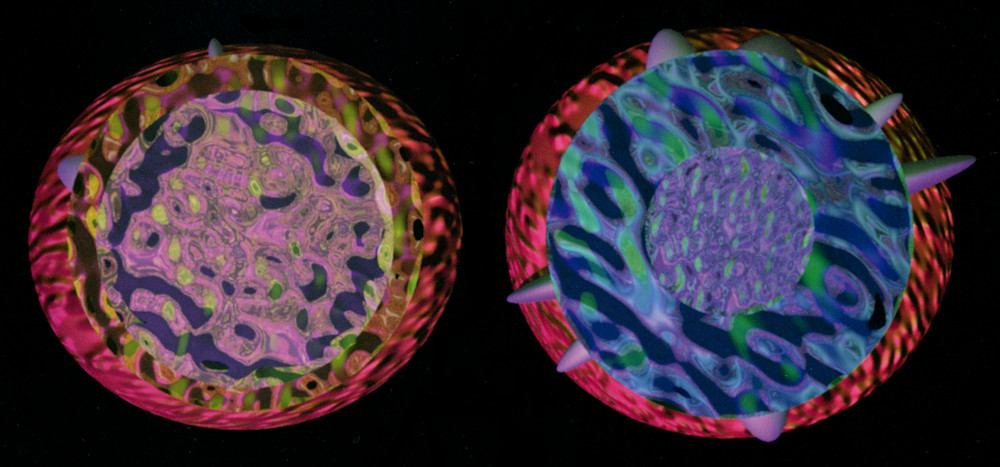
Somewhere in a sea of total blackness, strange insects float in the void. Weird abstract creatures, their form unknowable and their biology alien, fill the pages of Daizaburo Harada's Artificial Life. Like some kind of otherworldly biology textbook, it features countless weird and fantastical creatures row by row, grouped perhaps by some unseen scientist's criteria. Aside from artist's comments, the book is presented entirely free of text, encouraging the reader to come up with their own interpretation. Does this creature on one page relate to another creature? What kind of world could they live in? What are those appendages? Are these tentacles for grabbing food, or do they even have a mouth or the ability to eat at all?
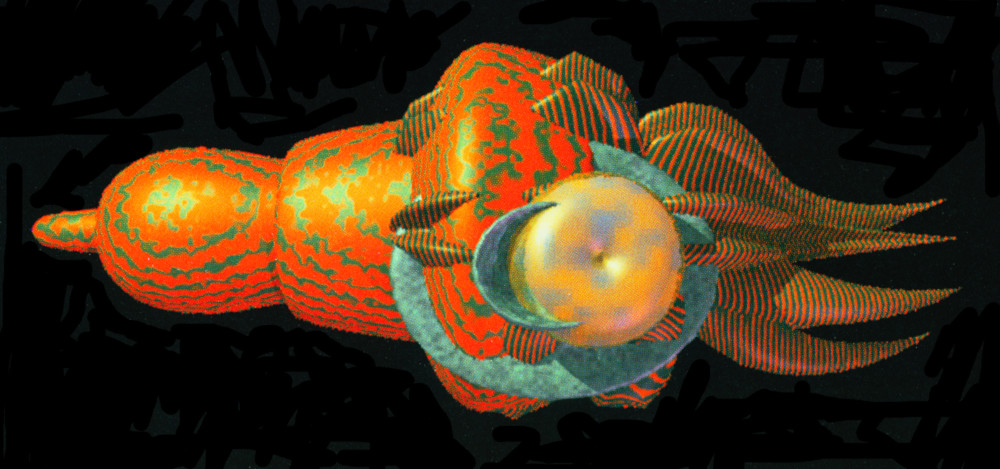
Published by Pioneer in 1993, right at the height of when an artist could still release a CG art book and make a splash, Artificial Life is an odd duck. The creator was a multidisciplinarian artist who had made his first big splash in the art world with TV War (1986), a collaboration with composer Ryuichi Sakamoto and digital artist Haruhiko Shono[1]. In the next decade he did a little bit of everything, from a live CGI concert with Ryuichi Sakamoto to producing the surreal imagery for NHK's science program The Universe Within II: The Human Brain & Mind.
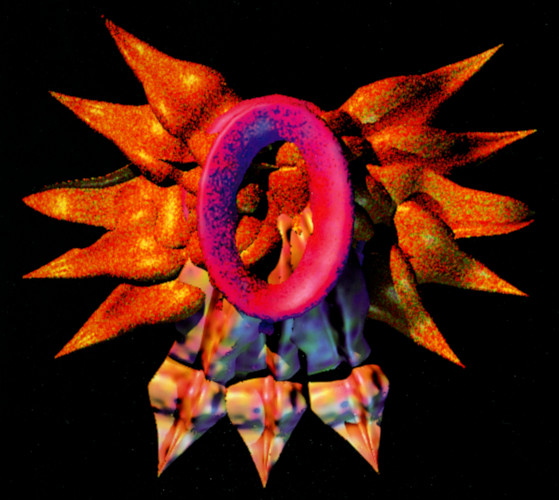
Meanwhile, he had been picking away at another ambitious project over the course of six years. Without a specific goal in mind, he began experimenting with unusual ways of generating 3D art, using random data and other procedural generation techniques to see what kind of imagery he could create. As time progressed, he started collecting a kind of bestiary—he leaned into an organic direction with his art, creating entities that were at once completely alien but also recognizable as a kind of life. The viewer can perhaps identify organic bits and pieces through the power of suggestion—an antenna here, a claw there, maybe a tentacle or two. But they feel like images from an alternate universe where evolution took a drastically different turn. At the time he was working on a scientific program, it might have felt strangely cathartic to work on something so completely unlike anything that existed in the real world. Dubbing these creations "insects", he began assembling an art book to showcase them.
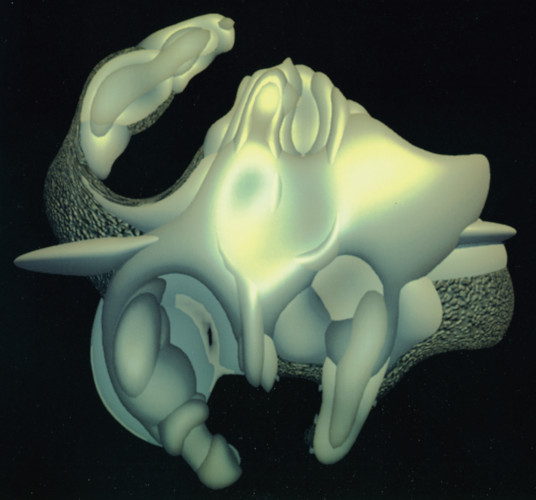
But what he'd end up with wasn't just an art book. Opposite the art book itself when the package is opened sits a paperback book containing an original novel: Judgment Engine, by American sci-fi author Greg Bear, which takes Harada's "insects" as a jumping off point and constructs a world for them.
Taking place in the final year before the Big Crunch leads to the final destruction of the universe and the birth of a new one, it follows a group of scientists preparing a final message to send forth into the new universe; some form of condensed truth, a way to help whatever future life forms along its path. At the core of this message is the ultimate scientific proof the dying universe discovered: "There can be no ultimate ethical advancement in this universe."[2] According to this proof, there can be no possibility of life that doesn't destroy something that came before it. As the scientists are wrapping up their work, a group of students stages a mutiny with the goal of disproving the proof and sending the seeds of a new form of life into the universe. They expend the universe's last energy burning through rapidly evolved life form after life form, and here it's not hard to see how the book came to be: in its descriptions of how "Snakes flow, sprout legs, wings beat the air. Animal relations, plant relations, new ecosystems"[3], we can see Harada's "insects" take shape.
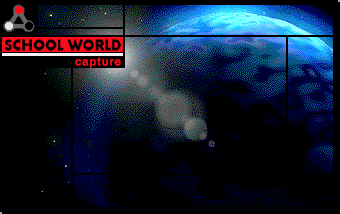
The third part of the project, School World, is a short CD-ROM game that explores the insects in motion. It's put together as two separate apps: Capture lets players fly through an alien planet and capture life forms. After capturing an insect, its data is saved onto the user's hard drive and the app closes; users can then open the separate Breed app to watch them. Breed is basically a virtual fish tank; players can watch their insects, but can also tweak the properties of the container the insects are living in. As their environment changes, insects mutate into new life forms. This isn't a Creatures-style game; there's no real purpose, and the insects aren't particularly interested in the player. It's more of a scientific observation station. The only "point" is whatever observation the players can make on their own, and what interests a player is up to them. Any given session is pretty short, but it doesn't have to be anything more than that, and there's something very compelling about scouring the planet for new kinds of life to watch.
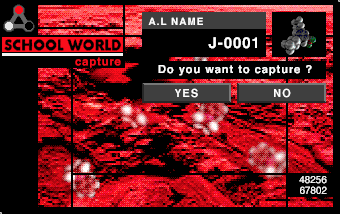
This is all helped greatly by the visual design, created by Digital Effects Laboratory's Yoshiyuki Okada. The forboding planet in Capture is drenched in a distinctly unnatural-looking red, and the ever-so-slightly glitchy flythroughs of the planet as the player navigates helps sell the idea that this is footage coming off of a drone making its descent. The heavy UI elements, which dominate the screen, also help greatly with immersion, as does the choice to restrict the game to a window in the player's desktop. The player genuinely feels immersed in the role of a scientist navigating this planet and then examining whatever specimen they've captured. It's easy to think of it as some kind of alternate universe scientific software, just one of many applications on a scientist's desktop. Even the save game format helps complete the illusion; the "INSECTS" folder on the player's hard drive contains the insect itself alongside the Breed executable, as though it's a record of sequenced DNA, and players can exchange these saved insects with other players to act the role of scientists sharing data with colleagues.
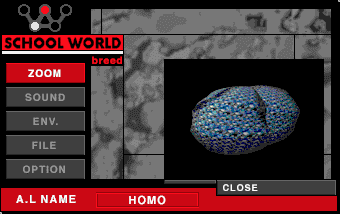
Harada's clearly the project's mastermind, but the other creators have the chance to share the spotlight. Judgment Engine was the product of a chance encounter between Harada and Bear, and it certainly feels like exactly the right pairing: he had written Blood Music (1985), a novel fascinated with the cosmic consequences of runaway evolution and nanotechnology, and Harada's artificial life seems to have intrigued him.
School World, similarly, feels like a collaboration which brought together just the right group of people. It was created by the little-known Digital Effects Laboratory (DEL)[4], a group of CG artists who had previously worked with Harada on TV War[5]. They seem to have spent most of their career doing work-for-hire[6], but School World gives the distinct impression of having been made with some real creative freedom. It certainly feels original, riffing off of the other two elements while having its own separate artistic goals.
Although the front cover and spine credit Harada first, and it's clear Harada's CG artwork is the real centrepiece here, the three works are presented as coequals. More than an art book, a novel, or a game, it's a project that shows how different mediums transform the same basic concepts. The three works don't just diverge because of different inspirations but because their mediums influence what kinds of interpretations are possible, what kinds of ideas can take root.
Harada's art approaches the "insects" from an aesthetic perspective. He seems fascinated with the idea of the grotesque. Maybe it's not a form of "beauty" exactly, but it has an otherworldly kind of appeal. They can be thought of not as a kind of life that serves a particular purpose, but almost a meditation on what we can recognize as life—something outerworldly, alien, but that still evokes the concepts of the organic. "What is life" is a philosophical question, but it's an aesthetic question too. What looks alive, what looks inert?
It's telling that Harada talks about his insects in terms of their alienation from the normal world. One of Harada's core motivations seems to have been a basic frustration with the limits of his own ability to perceive images[7]; the exotic artificial imagery of AL is an attempt to push his own ability to perceive, teasing his eyes with images that could never have existed a few years earlier. These images are abstractions, but they're not abstractions of concrete forms we recognize. They're abstractions of forms that reach beyond our ability to perceive. Harada's production process, too, seems designed to push the boundaries of the image itself; Sakamoto describes him as taking decidedly non-visual data, such as abstract sounds, and using them as the basis for his insects' visual design[8].
Bear, meanwhile, lands somewhere a bit more literal. His insects too are creations that represent the attempt to create something new, in his case the students' attempt to find an idealized form of life. But they live somewhere with a goal, and within a world that gives them form. It's their relationship to the creatures that surround them and to the enclosing narrative that gives them meaning. Harada deliberately avoids context, while Bear carefully employs it. Both Harada's and Bear's contributions to the project feel shaped by the form of their art. Bear is writing in concrete terms, and specifically in narrative terms. His insects need a world to inhabit and a story that gives them a reason to exist. Harada's insects, by comparison, live outside the world by their very nature. Bringing them into a narrative or a moral framework is by their nature impossible.
School World takes a third approach, balancing itself somewhere between the other two works. These insects are by necessity presented with surroundings that Harada's are missing, but they don't carry the weight of plot or moral force that Bear places on them. Instead, they benefit from the ambiguity and abstractness that many early computer games have. There are, thankfully, no instructions to tell the player exactly what is happening or what purpose their actions are serving. If players have already read Judgment Engine, they might choose to interpret their actions in the context of its plot, but the game itself doesn't force or even encourage any specific interpretation. That's really to its benefit; the game may be slight, but its entire purpose is discovery, and leaving as much as it can up to interpretation gives players more to think about than something more literal could have done.
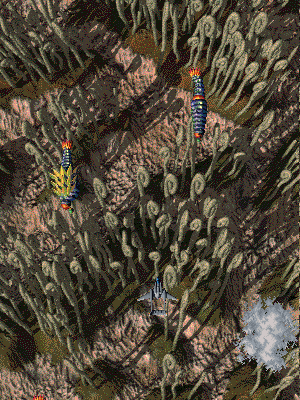
Harada would work on two more interactive projects before moving on to other media. DEL, under the new name Shadow Entertainment, collaborated with Harada on the 1996 Windows game The Legend of Eden 2[9], published by a little-known company called Afoon. Harada provided visual designs and CG artwork while Shadow Entertainment[10] created the game itself. Perhaps seeing the writing on the wall for the CD-ROM game market, Eden 2 is an arcade-style shooter targeted at a mainstream audience. The result is profoundly mediocre, and it's clear that the design staff lacks experience with the genre. The gameplay is awkward and slow-moving; the player's ship floats slowly across the stage, with limited and uninteresting offensive options. Enemy formations are simple and pose a limited challenge. The lack of understanding of how to work with the genre extends to the artwork too: Harada's imaginative and visually interesting designs go wasted, transformed as they are into small sprites that slide lifelessly across the backgrounds. The one part that truly shines is the enigmatic opening video, which features fascinating design work from Harada and surreal CG animation.
According to a 1996 issue of Saturn Fan[10], a few months after the PC version's release, Nippon Columbia were considering publishing a Sega Saturn version sometime in the near future. The article's screenshots come from the PC version, so it's possible that development of a Saturn version never began or was quickly abandoned.
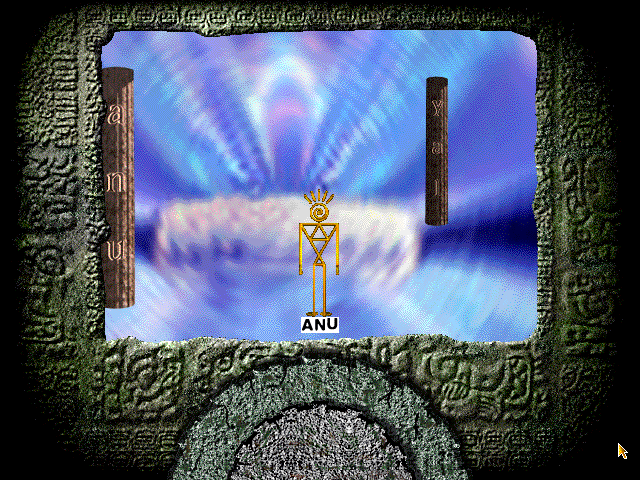
Harada and Shadow Entertainment worked together one last time on 1997's popol maya, an enigmatic adventure game in which players travel through surreal, dreamlike environments in which they learn to communicate with strange forms of life. In many ways it feels like a new take on the concept of School World, with the player positioned as a member of the world learning to communicate instead of at a scientist's detachment. popol maya is far too complex and interesting to summarize in one paragraph; it will probably appear in its own post someday. Shadsy's post at The Obscurity provides a much more in-depth guide.
This was Harada's final interactive work; he would continue working in other fields, but he wouldn't return to CD-ROM or games. Shadow Entertainment continued on for several more years, largely performing contract work on behalf of other companies.
1. Shono was a home multimedia pioneer in his own right, with his 1991 work Alice: I Can't Explain Myself setting the standard for many games to follow. It will eventually appear on this blog. ↩
2. Bear, Greg. "Judgment Engine." The Collected Short Fiction of Greg Bear, Volume Three. New York: Open Road Integrated Media, 2016. Ebook. ↩
3. Bear, Greg. "Judgment Engine." ↩
4. Harada, Daizaburo. (1993). AL: Artificial Life (Insects). Pioneer. Credits located on CD-ROM cover, reverse. See also this brief profile on the company's activities from former employee Hiroyuki Okui. ↩
5. Miyashita, Tatsuya. YMO Complete History: 1993. db:YMO. http://mmw4.web.fc2.com/dbymo/history1993.html ↩
6. Okada's short film Dokutsu may have been DEL's one original work, though information is scarce. ↩
7. AL, p. 8 ↩
8. AL, p. 14 ↩
9. 駿河屋 -<中古>THE LEGEND OF EDEN2(パソコンソフト). Suruga-ya. https://www.suruga-ya.jp/product/detail/145014906 ↩
10. (1996, November 15). The Legend of Eden 2. Saturn Fan, 203. Retrieved from https://archive.org/details/saturn-fan-1996-no.-23-11-15/page/202/mode/2up. Thanks to VGDensetsu for locating this article. ↩